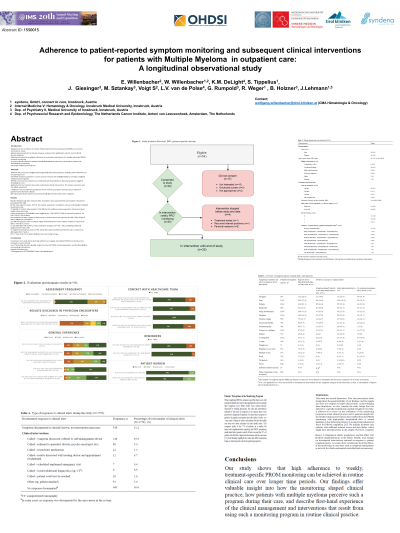QoL and Patient-Reported Outcome and Supportive Care
Poster Session 3
P-487: Adherence to patient-reported symptom monitoring and subsequent clinical interventions for patients with Multiple Myeloma in outpatient care:
A longitudinal observational study
Friday, September 29, 2023
1:15 PM - 2:15 PM EEST


Ella Willenbacher (she/her/hers)
PD Dr. med.
Innsbruck Medical University, Internal Medicine V: Hematology & Oncology, Innsbruck, Austria
Innsbruck, Tirol, Austria
Introduction:
Background: Use of software to monitor Patient-Reported Outcome Measures (PROMs) can improve outcomes for cancer
patients receiving anticancer therapy; however, evidence from applications used in routine clinical practice is lacking.
Objective: We aimed to investigate adherence to, and patient perceptions of a weekly, web-based PROM symptom monitoring
in routine clinical practice for patients with Multiple Myeloma. Moreover, we aimed to capture how clinical alerts prompted by
the system influenced clinical care.
Methods:
Methods: We conducted a single-center longitudinal observational study to evaluate patient adherence to and perceptions of
the PROM monitoring software in routine practice. Patients with Multiple Myeloma remotely completed weekly treatment-specific
PROMs to monitor key symptoms via a dedicated web-based platform. Alarming symptoms triggered clinical alerts in the
application for the treatment team who could initiate clinical interventions. The primary outcomes were the online assessment
completion rate and patients’ perceptions of the monitoring program assessed by an evaluation questionnaire. Moreover, clinical
alerts prompted by the system and consequential clinical interventions were analyzed.
Results:
Results: Between July 2021 and June 2022, 55 patients were approached for participation; 39 patients participated (24 male
[61%], mean age: 63.2 years, SD 9.2). The median assessment completion rate out of all weekly scheduled assessments was
70.3% (IQR 41.2-89.6). Most patients (77%) felt that the healthcare team was better informed on their health status due to the
online assessments. Clinical alerts were triggered for 1758/14639 (12.0%) of reported symptoms. For 548/1758 (31.2%) of alerts,
the symptom had been registered before and no further action was required; for 348/1758 (19.9%) of alerts, telephone consultation
and self-management advice sufficed. Higher-level interventions were seldom needed in response to alerts: referral to a doctor
or specialist (88/1758 of alerts, 5.0%), medication changes (22/1758, 1.3%), scheduling additional diagnostics (9/1758, 0.5%),
or unplanned emergency visits (7/1758, 0.4%). Most patients (55%) reported the calls in response to alerts gave them “quite a
bit” or “very much” of an added feeling of security during therapy.
Conclusions:
Conclusions: Our study shows that high adherence to regular and tailored PROM monitoring can be achieved in routine clinical
care. The findings provide valuable insight into how the PROM monitoring program and the clinical alerts and resulting interventions
shaped clinical practice.
Trial Registration: NCT05036863 (https://clinicaltrials.gov/)
Background: Use of software to monitor Patient-Reported Outcome Measures (PROMs) can improve outcomes for cancer
patients receiving anticancer therapy; however, evidence from applications used in routine clinical practice is lacking.
Objective: We aimed to investigate adherence to, and patient perceptions of a weekly, web-based PROM symptom monitoring
in routine clinical practice for patients with Multiple Myeloma. Moreover, we aimed to capture how clinical alerts prompted by
the system influenced clinical care.
Methods:
Methods: We conducted a single-center longitudinal observational study to evaluate patient adherence to and perceptions of
the PROM monitoring software in routine practice. Patients with Multiple Myeloma remotely completed weekly treatment-specific
PROMs to monitor key symptoms via a dedicated web-based platform. Alarming symptoms triggered clinical alerts in the
application for the treatment team who could initiate clinical interventions. The primary outcomes were the online assessment
completion rate and patients’ perceptions of the monitoring program assessed by an evaluation questionnaire. Moreover, clinical
alerts prompted by the system and consequential clinical interventions were analyzed.
Results:
Results: Between July 2021 and June 2022, 55 patients were approached for participation; 39 patients participated (24 male
[61%], mean age: 63.2 years, SD 9.2). The median assessment completion rate out of all weekly scheduled assessments was
70.3% (IQR 41.2-89.6). Most patients (77%) felt that the healthcare team was better informed on their health status due to the
online assessments. Clinical alerts were triggered for 1758/14639 (12.0%) of reported symptoms. For 548/1758 (31.2%) of alerts,
the symptom had been registered before and no further action was required; for 348/1758 (19.9%) of alerts, telephone consultation
and self-management advice sufficed. Higher-level interventions were seldom needed in response to alerts: referral to a doctor
or specialist (88/1758 of alerts, 5.0%), medication changes (22/1758, 1.3%), scheduling additional diagnostics (9/1758, 0.5%),
or unplanned emergency visits (7/1758, 0.4%). Most patients (55%) reported the calls in response to alerts gave them “quite a
bit” or “very much” of an added feeling of security during therapy.
Conclusions:
Conclusions: Our study shows that high adherence to regular and tailored PROM monitoring can be achieved in routine clinical
care. The findings provide valuable insight into how the PROM monitoring program and the clinical alerts and resulting interventions
shaped clinical practice.
Trial Registration: NCT05036863 (https://clinicaltrials.gov/)
